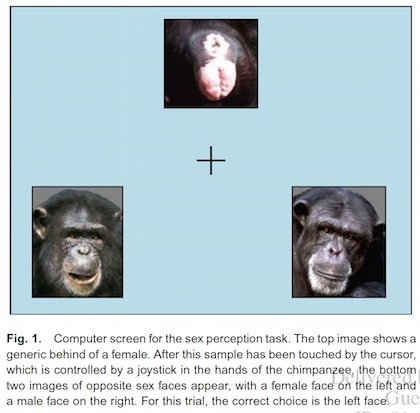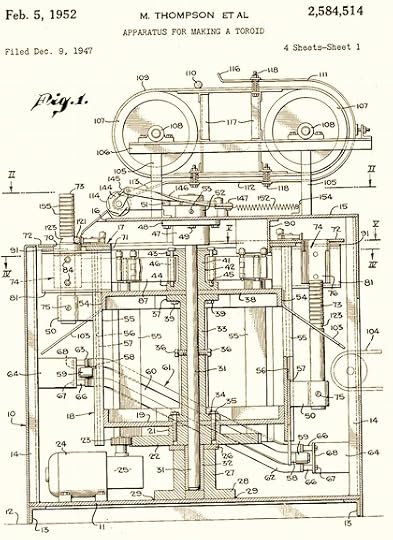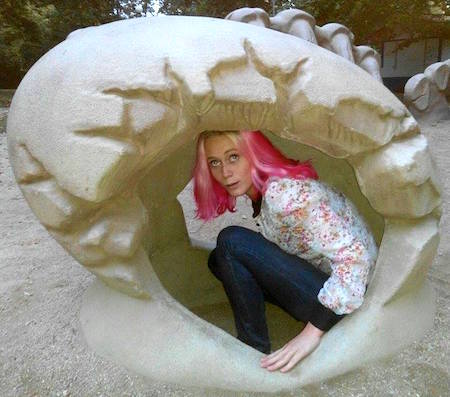Marc Abrahams's Blog, page 302
October 16, 2015
New punch sensations for VR gamers
When boxing or fencing, players are unlikely to miss the sensation of being hit by an opponent. That’s not usually the case, of course, for VR gamers. But change might be on the horizon thanks to “impacto, a device designed to render the haptic sensation of hitting and being hit in virtual reality”. Researchers Lopes, P., Ion, A., and Baudisch, P. will present their paper: ‘Impacto: Simulating Physical Impact by Combining Tactile Stimulation with Electrical Muscle Stimulation.’ at the ACM Symposium on User Interface Software and Technology (UIST), Nov. 8-11, 2015, Charlotte, North Carolina, US.
Bonus question (optional): Are there any other (non-gaming) spheres where such tech. might find applications?

Nastasia Okulova joins the Luxuriant Flowing Hair Club for Scientists (LFHCfS)
Nastasia Okulova has joined the Luxuriant Flowing Hair Club for Scientists (LFHCfS). She says:
I recently started my Ph.D studies in the field of micro and nanotechnologies working with polymers and surface structures. It is a pity that all this luxurious flowing hair has to be kept underneath the cleanroom suit while working in the lab every day.
Nastasia Okulova, LFHCfS
Ph.D student
Technical University of Denmark
Copenhagen, Denmark


October 15, 2015
Fictophones – a curiously unstable class of musical instruments?
Does this video, showing sound sculptor Henry Dagg performing ‘Somewhere over the Rainbow’ on a Faux-Katzenklavier of his own construction, qualify as a fictophonic collapse scenario?
First, some background. Musicologists often like to categorise instruments into classes or groups. For example – idiophones (vibrating bodies), membranophones (vibrating membranes), chordophones (vibrating strings), aerophones (vibrating air columns), and electrophones (electronic instruments). Recently a further category fictophones (imaginary musical instruments) has been proposed by Professor Deirdre Loughridge (University of California, Berkeley) and colleague (Curtis Institute of Music, Philadelphia). Their website ‘The Museum of Imaginary Instruments’ provides a list of such things, including, for example, the Katzenklavier (a cat organ or cat piano).
So, returning to the question posed above, here is a BONUS TASK (optional)
Thesis
The musical instrument category of ‘fictophones’ (imaginary musical instruments) is an inherently unstable one – in that if anyone were to construct such an instrument, it would cease to be a member of its own class.
Discuss
Further reading: The Cat Keyboard was first described (it’s said) by Athanasius Kircher in the corollary of chapter 1 (Musica Organica), of his work Musurgia universalis (1650) – a copy of which may be found here, in its original Latin. [caution: a somewhat ‘sticky’ 10MB pdf download]

October 14, 2015
Specificity: The effects of these on those
“What, specifically, do you want to know?” is a question no one needs ask about this study. The answer is in the title:
“Aggregated Effects of Combining Daily Milk Consumption And Aerobic Exercise on Short-Term Memory and Sustained Attention Among Female Students,” In-Tyng Leong, Sedigheh Moghadam and Hairul A. Hashim [pictured here], Perceptual and Motor Skills, epub January 2015. The authors, at Universiti Sains Malaysia, explain:
“This study examined the combined effects of milk supplementation and aerobic exercise on the short-term memory and sustained attention of female students aged 16 yr. (N = 81). The intervention involved serving of 250 ml of regular milk during school days and/or a 1-hr. aerobic exercise period twice per week for 6 weeks. The Digit Span Test and Digit Vigilance Test were used to measure short-term memory and sustained attention, respectively. The combination group (milk and exercise) and exercise group performed significantly better than did the milk and control groups in terms of short-term memory.”

Podcast #33: Make sure colonoscopy patients will not explode
Chimpanzees recognizing photographs of the rear ends of other chimpanzees; colonoscopy patients who explode, and the patent for the bagel-making machine — all these all turn up in this week’s Improbable Research podcast.
Click on the “Venetian blinds” icon — at the lower right corner here — to select whichever week’s episode you want to hear:
SUBSCRIBE on Play.it, iTunes, or Spotify to get a new episode every week, free.
This week, Marc Abrahams tells about:
The rest (following on from the last two weeks) of the things that won Ig Nobel Prizes in 2012. (“Faces and Behinds: Chimpanzee Sex Perception” Frans B.M. de Waal and Jennifer J. Pokorny, Advanced Science Letters, vol. 1, 99–103, 2008. Here’s detail from the study:
 / “Colonic Gas Explosion During Therapeutic Colonoscopy with Electrocautery,” Spiros D Ladas, George Karamanolis, Emmanuel Ben-Soussan, World Journal of Gastroenterology, vol. 13, no. 40, October 2007, pp. 5295–8. / “Argon Plasma Coagulation in the Treatment of Hemorrhagic Radiation Proctitis is Efficient But Requires a Perfect Colonic Cleansing to Be Safe,” E. Ben-Soussan, M. Antonietti, G. Savoye, S. Herve, P. Ducrotté, and E. Lerebours, European Journal of Gastroenterology and Hepatology, vol. 16, no. 12, December 2004, pp. 1315-8. Featuring dramatic readings by Daniel Rosenberg
.
) Here, by the way, is video of how two friends did their own personal prep for a colonoscopy:
/ “Colonic Gas Explosion During Therapeutic Colonoscopy with Electrocautery,” Spiros D Ladas, George Karamanolis, Emmanuel Ben-Soussan, World Journal of Gastroenterology, vol. 13, no. 40, October 2007, pp. 5295–8. / “Argon Plasma Coagulation in the Treatment of Hemorrhagic Radiation Proctitis is Efficient But Requires a Perfect Colonic Cleansing to Be Safe,” E. Ben-Soussan, M. Antonietti, G. Savoye, S. Herve, P. Ducrotté, and E. Lerebours, European Journal of Gastroenterology and Hepatology, vol. 16, no. 12, December 2004, pp. 1315-8. Featuring dramatic readings by Daniel Rosenberg
.
) Here, by the way, is video of how two friends did their own personal prep for a colonoscopy: List of everything that won an Ig Nobel Prize in 2012.
Farewell, bagel-making-machine inventor (“Daniel Thompson, Whose Bagel Machine Altered the American Diet, Dies at 94,” New York Times, September 21, 2015. / “Apparatus for making a toroid,” U.S. 2584514, granted to Meyer Thompson and Daniel Thompson, priority December 9, 1947. Featuring dramatic readings by Sue Wellington . ) Here’s part of the bagel-making-machine patent:

The mysterious John Schedler or the shadowy Bruce Petschek perhaps did the sound engineering this week.
The Improbable Research podcast is all about research that makes people LAUGH, then THINK — real research, about anything and everything, from everywhere —research that may be good or bad, important or trivial, valuable or worthless. CBS distributes it, on the CBS Play.it web site, and on iTunes and Spotify).

October 13, 2015
Structure of Pigments of the Red Sweat of the Hippopotamus
Your notion of the structure of hipposudoric and norhipposudoric acids, pigments of the red sweat of the hippopotamus, may need some updating. This newly published study calls for your attention:
“Refined Structure of Hipposudoric and Norhipposudoric Acids, Pigments of the Red Sweat of the Hippopotamus,” Takatoshi Matsumoto, Yoko Saikawa, Masaya Nakata, and Kimiko Hashimoto, Chemistry Letters, epub 2015. (Thanks to T Brian H McMurry for bringing this to our attention.) The authors are at Keio University, Japan.
BONUS: Video of one way to collect sweat from a hippo:

October 12, 2015
Andrew Sayer joins the Luxuriant Flowing Hair Club for Scientists (LFHCfS)
Andrew Sayer has joined the Luxuriant Flowing Hair Club for Scientists (LFHCfS). He says:
I am a physicist working on atmospheric remote sensing. The long hair certainly helps in my research, which is basically examining things from a distance.
Research scientist
NASA Goddard
Greenbelt, Maryland, USA


Melanie During joins the Luxuriant Flowing Hair Club for Scientists (LFHCfS)
Melanie During has joined the Luxuriant Flowing Hair Club for Scientists (LFHCfS). She says:
I am a Vertebrate Paleontologist, and currently still a masters student, I am also an assistant in Big History (the field that covers everything) and a volunteer preparator at the Natural History Museum in Leiden. For the past 5 years I have been almost consistently pink-haired, and my ambitions are not just being a paleontologist, but making scientific documentaries as well.
Melanie A.D. During, LFHCfS
Masters student in Vertebrate Paleontology
Naturalis — Natural History Museum, Leiden
Amsterdam, Netherlands


Social Media + BS
 “What does the future hold for social media and bullshit?” asks professor Rasmus Kleis Nielsen (Univ. Oxford, UK) in a new communication published in the journal Social Media + Society (“An online, open-access, peer-reviewed scholarly journal deeply committed to advancing the understanding of social media and its impact on societies past, present and future.”) The professor offers the hypothesis that bullshit is particularly common when it comes to social media (though he also points out that “No-one has a monopoly on bullshit.”)
“What does the future hold for social media and bullshit?” asks professor Rasmus Kleis Nielsen (Univ. Oxford, UK) in a new communication published in the journal Social Media + Society (“An online, open-access, peer-reviewed scholarly journal deeply committed to advancing the understanding of social media and its impact on societies past, present and future.”) The professor offers the hypothesis that bullshit is particularly common when it comes to social media (though he also points out that “No-one has a monopoly on bullshit.”)
“One thing I think we can say (and this essay outlines my justifications for that claim) is that bullshit is here to stay and will continue to play an important role for how we understand social media, how they are used, and for what they mean. Therefore, we need to take bullshit seriously as an intellectual and analytical problem.”
See: ‘Social Media and Bullshit’, Social Media + Society, April-June 2015
Further reading: ‘Taurascatics’.

October 11, 2015
Boxer vs wrestler
An old theoretical question — can a professional wrestler defeat a professional boxer? — got an early test of sorts in 1976, when Antonio Inoki fought Muhammad Ali:
That same evening, wrestler Andre the Giant (who in his youth often rode with the playwright Samuel Beckett, but may never have wrestled with or boxed Beckett) fought boxer Chuck (“the Bayonne bleeder”) Wepner:
BONUS: The Guardian‘s look back at the bout.
BONUS: The other Andre the Giant — the chess player

Marc Abrahams's Blog
- Marc Abrahams's profile
- 14 followers



